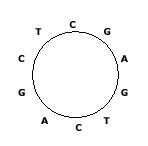UVA - 1584 Circular Sequence(水)
2015-03-16 17:36
127 查看
Circular Sequence
Submit Status
Description

Some DNA sequences exist in circular forms as in the following figure, which shows a circular sequence ``CGAGTCAGCT", that is, the last symbol ``T" in ``CGAGTCAGCT" is connected to the first symbol ``C". We always read a circular
sequence in the clockwise direction.

Since it is not easy to store a circular sequence in a computer as it is, we decided to store it as a linear sequence. However, there can be many linear sequences that are obtained from a circular sequence by cutting any place
of the circular sequence. Hence, we also decided to store the linear sequence that is lexicographically smallest among all linear sequences that can be obtained from a circular sequence.
Your task is to find the lexicographically smallest sequence from a given circular sequence. For the example in the figure, the lexicographically smallest sequence is ``AGCTCGAGTC". If there are two or more linear sequences
that are lexicographically smallest, you are to find any one of them (in fact, they are the same).
file. Each test case takes one line containing a circular sequence that is written as an arbitrary linear sequence. Since the circular sequences are DNA sequences, only four symbols, A, C, G and T,
are allowed. Each sequence has length at least 2 and at most 100.
The following shows sample input and output for two test cases.
Sample
Sample
字符串水题,枚举法就好了,知识点在用取模实现循环。
| Time Limit: 3000MS | Memory Limit: Unknown | 64bit IO Format: %lld & %llu |
Description

Some DNA sequences exist in circular forms as in the following figure, which shows a circular sequence ``CGAGTCAGCT", that is, the last symbol ``T" in ``CGAGTCAGCT" is connected to the first symbol ``C". We always read a circular
sequence in the clockwise direction.

Since it is not easy to store a circular sequence in a computer as it is, we decided to store it as a linear sequence. However, there can be many linear sequences that are obtained from a circular sequence by cutting any place
of the circular sequence. Hence, we also decided to store the linear sequence that is lexicographically smallest among all linear sequences that can be obtained from a circular sequence.
Your task is to find the lexicographically smallest sequence from a given circular sequence. For the example in the figure, the lexicographically smallest sequence is ``AGCTCGAGTC". If there are two or more linear sequences
that are lexicographically smallest, you are to find any one of them (in fact, they are the same).
Input
The input consists of T test cases. The number of test cases T is given on the first line of the inputfile. Each test case takes one line containing a circular sequence that is written as an arbitrary linear sequence. Since the circular sequences are DNA sequences, only four symbols, A, C, G and T,
are allowed. Each sequence has length at least 2 and at most 100.
Output
Print exactly one line for each test case. The line is to contain the lexicographically smallest sequence for the test case.The following shows sample input and output for two test cases.
Sample
Input
2 CGAGTCAGCT CTCC
Sample
Output
AGCTCGAGTC CCCT
字符串水题,枚举法就好了,知识点在用取模实现循环。
#include<iostream>
#include<algorithm>
#include<cmath>
#include<cstring>
#include<string>
using namespace std;
const int MAXN = 105;
int main()
{
int casen;
cin >> casen;
while (casen--)
{
char s[MAXN][MAXN] = {"0"};
char ans[MAXN];
cin >> s[0];
strcpy(ans, s[0]);
int len = strlen(s[0]);
for (int i = 1; i < len; i++)
{
for (int j = 0; j < len; j++)
s[i][j] = s[0][(j + i) % len];
if (strcmp(ans, s[i])>0) strcpy(ans, s[i]);
}
cout << ans << endl;
}
}
相关文章推荐
- UVA 1584 - Circular Sequence(环状序列)(字典序)
- UVa 1584 - Circular Sequence
- Circular Sequence UVA - 1584
- 环状序列(UVA1584)
- UVa 1584 - Circular Sequence
- 算典03_例题_06_Uva-1584
- UVA - 1584 Circular Sequence
- UVa 1584
- UVa 1584 Circular Sequence --- 水题
- Uva1584
- UVA - 1584 Circular Sequence
- 环装序列 (Circular Sequence, ACM/ICPC Seoul 2004, UVa1584)
- UVa 1584 - Circular Sequence
- Uva - 1584 - Circular Sequence
- uva_1584_Circular Sequence
- 3_6 环状序列(UVa1584)
- UVA.1584 环状序列
- uva 1584 Circular Sequence(环状串的最小字典序表示法)
- UVA1584 - Circular Sequence
- UVA1584-Circular Squence
